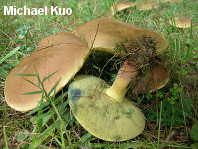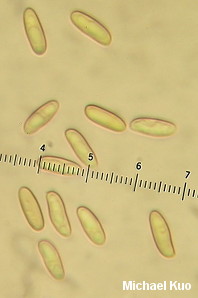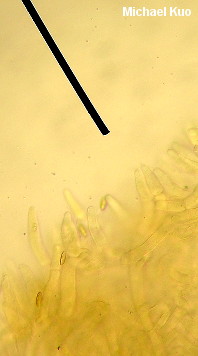| Major Groups > Boletes > "Boletus" | Red-Capped, Blue Staining > Boletus carminipes |

|
Boletus carminipes [ Basidiomycota > Boletales > Boletaceae > Boletus . . . ] by Michael Kuo When young, Boletus carminipes is yet another reddish-capped, blue-staining bolete, but it soon begins to change color, and the cap becomes yellow-brown--making it yet another brown-capped, blue-staining bolete. If you have collected both young and mature specimens, the color transformation itself is a good way of tentatively identifying the species. Without specimens representing all stages of development, however, you may be required to address more erudite features: the stem is mostly yellowish, with a carmine red base; the spores are quite narrow (3-3.5 µ wide); and the cap surface turns fleetingly blue with ammonia (a fact not previously reported, to my knowledge). Description: Ecology: Mycorrhizal; host associations undocumented; the illustrated and described collection, from Kentucky, was made in a grassy area under white pine, hemlock, and oaks; growing scattered or gregariously; summer and fall; possibly widely distributed east of the Rocky Mountains. Cap: 4-15 cm; convex, becoming broadly convex; dry; finely velvety when very young, but soon bald; reddish cinnamon at first, but soon changing to yellow-brown; the margin often paler. Pore Surface: Yellow at first, becoming olive yellow; bruising promptly blue; with 1-2 circular to angular pores per mm; tubes shallow, to 8 mm deep; long remaining adnate. Stem: 4-8 cm long; 1-2 cm thick; more or less equal; bright yellow at the apex; yellowish to brownish overall, with a persistently carmine red base; bald; dry; not reticulate; basal mycelium white. Flesh: Whitish to pale yellow in cap; yellow in stem; staining promptly blue when sliced. Odor and Taste: Not distinctive. Chemical Reactions: Ammonia quickly blue, then fading on cap surface; pale orange (but erasing blue) on flesh. KOH negative to orangish on cap surface; dull orange on flesh. Iron salts gray on cap surface; negative on flesh. Spore Print: Olive brown. Microscopic Features: Spores 9-11 x 3-3.5 µ; subfusiform; smooth; yellow in KOH; brownish in Melzer's. Hymenial cystidia lageniform; to about 50 x 12.5 µ. Pileipellis a collapsing trichoderm of elements 5-12.5 µ wide; terminal cells usually tubular with rounded apices, but occasionally cystidioid, varying from obnapiform to fusoid or fusoid-ventricose; yellow to ochraceous in KOH. REFERENCES: Smith & Thiers, 1971. (Smith, Smith & Weber, 1981; Both, 1993; Bessette, Roody & Bessette, 2000.) Herb. Kuo 08180601. This site contains no information about the edibility or toxicity of mushrooms. |
© MushroomExpert.Com |
|
Cite this page as: Kuo, M. (2014, December). Boletus carminipes. Retrieved from the MushroomExpert.Com Web site: http://www.mushroomexpert.com/boletus_carminipes.html |


